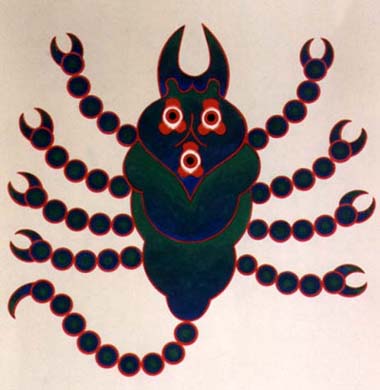
Scorpion
Painting by Thrinlé Khandro
Scorpion in Tibetan – digpa ratsa (bsDigs pa ra tsa) – means negative
action or harmful action (also menace or threat). Of all images, that of
the scorpion fully portrays the power of Vajrayana in terms of what is meant by
transformation. Ngak’chang Rinpoche says of the scorpion:
The wrathful symbolism of Vajrayana is often misunderstood in the West
because of our cultural predisposition to polarise ‘good’ and ‘evil’.
The polarity of ‘good and evil’ does not exist in Buddhism – there is only
the ‘good’ of the enlightened state, and the distortion of that ‘good’.
This means that no matter how negative a situation or person may have become
through dualistic obsession – that situation or person can be transformed. The
power of transformation is thus depicted in Vajrayana through the scorpion. The
statement being made here is that: ‘If the scorpion can be transformed then
anyone, and anything can be transformed.’ Everyone and everything – is nothing
other than the energy of the non-dual state – and therefore the power of every
facet of existence can be harnessed through pure vision as a means of attainment
and compassionate activity.
Khandro Déchen says of the scorpion:
This image is found in many places in Vajrayana awareness imagery. It
is found in the awareness images of the wrathful awareness beings such as Dorje
Tröllö (rDo rJe gro lod) and Tsogyel
Tröllö (tshog rGyal gro lod). It is also found in the depictions of
the protectors such as the scorpion horned minion
Digpa Ru-srin (bsDigs pa ra tsa ru can mGo srin) of Za Rahula. The scorpion
is often used as a seal by Tantric Lamas.
Ngak’chang Rinpoche has a scorpion seal, and Chögyam
Trungpa Rinpoche’s scorpion seal sometimes appears on his calligraphies.
This scorpion is unique inasmuch as, its leg sections are five fold, its tail
sections are ninefold, and it has a ‘wisdom eye’. It is painted in blue,
green, and red – the colours of space, air, and fire. A scorpion of this type
can be found on the Aro gTér wrathful empowerment shawl.
When the apostate king Langdarma attempted to destroy Buddhism in Tibet, the
mahasiddha Sang-gyé Yeshé terrified Langdarma by
employing a wrathful mudra to create the apparition of a scorpion to appear above
Langdarma’s head. The scorpion was the size of nine yaks. This experience
caused the king to desist in his persecution of the gö-kar-chang-lo’i-dé
(gos dKar lCang lo’i sDe). Dig-dzub Chagya (bsDigs mDzub phyag rGya) – the
‘forefinger-scorpion gesture’ is a threatening mudra which employs the
extended forefinger and index-finger.
